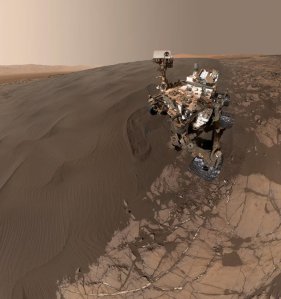
It looks like a scene from Star Wars. But it’s actually a lot closer to home than Tatooine.
This 360 degree interactive photograph of Mars lets you explore the terrain of the red planet from the comfort of your own home. Note: Please open this page with your phone in order to use the interactive image. You may need to open it with the browser, and not the Facebook app.
“From Where I Stand”
NASA released the photo taken by the Mars Curiosity rover just a day after it sent back a selfie taken at the Namib Dune, where it was collecting sand for lab analysis.

The interactive image posted to Curiosity’s Facebook page was captioned,
“Use your smart phone to explore Mars with me in 360 degrees. #FromWhereIStand”
The team also shared a short video explaining how the rover is able to take selfies using the Mars Hand Lens Imager camera on the end of its arm.
Although it has not yet been officially revealed how the 360 degree shot was obtained, it seems likely that the same arm is the source. And as many Facebook commenters note, it is likely a composite of photos taken by the camera, and this is likely the case (though some areas may have been filled in with digital editing).
In addition to the sandy, rippling views of the cascading Namib Dune, viewers will also see a portion of Mount Sharp in the distance. The site is part of the dark-sand “Bagnold Dunes” field along the northwestern flank of Mount Sharp. Images taken from orbit indicate that dunes in the Bagnold field move as much as about 1 meter (3 feet) per Earth year, according to NASA.
Studying the Dunes
The Curiosity rover first landed on Mars on August 6, 2012. It’s initial mission was to “determine whether Mars once offered environmental conditions favorable for microbial life.” This mission was deemed successful after it discovered an ancient riverbed.
The rover reached the base of Mount Sharp in 2014. The main mission objective now is to reach the higher layers of the mountain and to investigate how the wind moves the sand on the Bagnold Dunes in low gravity.
Perhaps, once the rover does reach new heights, we will be treated to more interactive views from the dunes.